NEW ORDER OF THE LATTER RAIN
NEW ORDER OF THE LATTER RAIN TIMELINE
1947 (Spring): George Hawtin, a Pentecostal Assemblies of Canada pastor, founder of the college, and its principal, resigned under pressure from Bethel Bible College Saskatoon. Faculty member Percy G. Hunt resigned in sympathy.
1947 (October 21): Hawtin and Hunt joined Herrick Holt, in a new work, Sharon Orphanage and Schools.
1947 (Late Fall): Hawtin and Hunt, with several others, attended a Vancouver, British Columbia, revival led by healing evangelist William Branham.
1947-1948 (Winter): Hawtin and others promoted a regime of long fasts and prayer meetings modeled on Branham’s revivals and the book, Atomic Power with God through Fasting and Prayer, by Franklin Hall.
1948 (February 11): A young woman student reported a prophecy of a door opening into a gift of ministry in the body of Christ. Revival broke out on campus, drawing outsiders.
1948 (Easter): Special services described as The Feast of Pentacost drew large numbers of people to the campus.
1948 (July 7-18): What is considered the first Camp Meeting was held on campus, drawing worshipers in the thousands from all over Western Canada and places in the U.S. The teachings of this revival became known as The Latter Rain and spread widely.
1949: General Council of the Assemblies of God USA condemned Latter Rain teachings. At least one key official resigned in protest, and the issue almost split the denomination.
1949 (Late): Leadership of the movement began to slip from the hands of the Sharon group as other centers developed.
1952: As an organized movement, the Latter Rain began to fade.
1967: Characteristic Latter Rain positions became major elements of the Charismatic Renewal movement.
Present Day: Latter Rain theology is central to numerous movements, such as the Vineyard Churches, The Kansas City Prophets, and the Toronto and Lakeland revivals, as well as hundreds of independent neo-Pentecostal churches.
FOUNDER/GROUP HISTORY
Several authors have placed the beginnings of the Latter Rain movement of the late 1940s (sometimes called the New Order of the Latter Rain to distinguish it from at least two earlier uses of the term “Latter Rain”) in a context of a Pentecostal renewal already well underway. Many Pentecostals felt that, after the Azusa Street period, Pentecostalism had become “dry” or had “cooled off” because it had lost its focus on the emotional, supernatural, and ecstatic manifestations of the Holy Spirit (Riss 1987:Chapters 1 and 2).
Several movements in the early war years had begun to examine this loss of supernatural emphasis and had spawned a generation of “Healing Revival” preachers, among them William Branham, who started his ministry somewhat later (1946). This made him contemporary with several better known revivalists, such as Billy Graham and Oral Roberts. But Branham was somewhat further outside of the mainstream, with his heavy concentration on casting out demons, supernatural healing, laying on of hands, end time predictions, and his contention that the doctrine of the Holy Trinity was wrong (Riss 1987:1-2, Chapters 1 and 2).
Meanwhile, a minister of the Pentecostal Assemblies of Canada (PAOC) known for his “unrestrained zeal,” George Hawtin, became 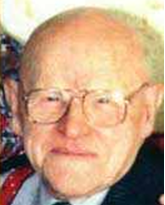 involved in a dispute with the Saskatchewan District of the PAOC. Several years earlier, Hawtin had founded Bethel Bible College, then in Saskatoon. He had sold the college property to the district in order for the college to become an official institution of the district. He was soon in trouble with the district administration for, among other things, making decisions without informing or asking permission of the district. There were also questions about the college’s academic standards. In the late spring of 1947, Hawtin’s resignation was sought and given. Faculty member Percy G. Hunt resigned in sympathy (Riss 1987:53-55; Holdcroft 1980:2).
involved in a dispute with the Saskatchewan District of the PAOC. Several years earlier, Hawtin had founded Bethel Bible College, then in Saskatoon. He had sold the college property to the district in order for the college to become an official institution of the district. He was soon in trouble with the district administration for, among other things, making decisions without informing or asking permission of the district. There were also questions about the college’s academic standards. In the late spring of 1947, Hawtin’s resignation was sought and given. Faculty member Percy G. Hunt resigned in sympathy (Riss 1987:53-55; Holdcroft 1980:2).
That fall, Hawtin and Hunt joined Herrick Holt, pastor of the Four Square Gospel church of North Battleford, Saskatchewan, in a new venture, Sharon Orphanage and Schools, founding that organization’s Bible college and becoming the nucleus of its first faculty. A substantial number of students from Bethel transferred to the new school (Holdcroft 1980:3).
At about the same time, Hawtin and others from Sharon journeyed to Vancouver, British Columbia, to attend a revival led by William Branham. They were deeply impressed by the supernatural and ecstatic elements of the revival, aspects of Pentecostalism they felt had been lost over the years. They also became aware of a book, Atomic Power With God through Fasting and Prayer, by Franklin Hall, which proposed that one could reach a level of direct communication with God by fasting for long periods (as much as 40 days) and engaging in extended periods of intense prayer (Riss 1987:56-60).
On the group’s return to North Battleford, they promoted the practices proposed by Hall and encouraged prayer for an “outpouring of the Holy Spirit” similar to what they had seen in the Branham revivals Riss 1987:60-63).
Students took up the challenge. On February 11, 1948, following a regime of fasting and prayer, one of them, a young woman, reported a prophecy involving an open door which was “an invitation for students to pass through into gifts and ministry in the Body of Christ.” Revival broke out on campus, classes were cancelled. Outsiders heard about what was happening and joined in (Holdcroft 1980:3).
Revival continued, including supernatural “signs and wonders.” Leaders, following Branham’s example, began “calling out” individual students, laying hands on them in order to impart “blessing in the spirit” (something Pentecostals had always believed involved “tarrying,” waiting prayerfully for the Lord) and then giving prophecies for each individual (Holdcroft 1980:3).
At Easter of that year (1948), the school held special services described as The Feast of Pentecost. The event drew large numbers of people to campus and led to the organization of what is considered the first Camp Meeting, held July 7-18, 1948. For this event, the attendance was in the thousands (Riss 1987:66-68).
By this time, the revival was becoming somewhat structured, and it was the teachings of this revival that, collectively, came to be called the Latter Rain, a term that had been in use periodically, at least since the late nineteenth century, to identify a particularly enthusiastic and emotional element in the developing Holiness and Pentecostal movements (Holdcroft 1980:1, 4-7).
These teachings, which were largely proclaimed as direct prophecy, generally followed the lines of phenomenon observed at
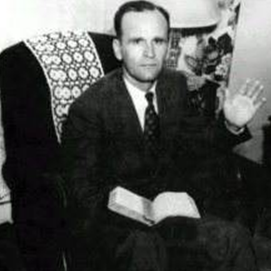 Azusa Street and in the meetings of William Branham. They included such things as speaking in tongues, being “slain in the spirit,” being baptized in the spirit, supernatural healing, singing in tongues (“heavenly choirs”), laying on of hands, and an imminence of end times, among others (Riss 1987:72-74).
Azusa Street and in the meetings of William Branham. They included such things as speaking in tongues, being “slain in the spirit,” being baptized in the spirit, supernatural healing, singing in tongues (“heavenly choirs”), laying on of hands, and an imminence of end times, among others (Riss 1987:72-74).
These teachings spread very widely very quickly, splitting or absorbing a number of established Pentecostal churches and becoming a movement within a few months. While Latter Rain teachings valued relational networks and condemned denominationalism (contending that no church or organization had any right to give direction to any other church), the Sharon group early on formed a team of “Presbyters” who visited Latter Rain churches and essentially managed the movement through directive prophecy (Riss 1987:67-74; Holdcroft 1980:4, Apologetic Index n.d.:4).
By mid-1949, the movement had become a major concern for more orthodox Pentecostals. The General Council of The Assemblies of God USA meeting that year formally condemned Latter Rain teachings as unbiblical and heretical (Riss 1987:103-19).
In the meantime, several other centers formed. The first one was the Elim Bible Institute in New York, which had already been involved in attempts to revive a more emotional and supernaturally focused Pentecostalism and which already had the resources to compete with the Sharon group. The second center to rise to a position of influence was the Bethesda Missionary Temple in Detroit, Michigan; another soon followed in Texas. Leadership and control of the movement were quickly sliding out of the hands of the Sharon group and beginning to fragment (Riss 1987:103-10).
By 1952, the Latter Rain as a recognized movement was clearly beginning to fade, although a number of strong congregations continue into the present day. Also, a number of Latter Rain teachings became major parts of the Charismatic Renewal movement that blossomed starting about 1967 (Riss 1987:140-43).
Much Latter Rain teaching is central in numerous contemporary movements, such as the Vineyard Churches, The Kansas City Prophets, and the Toronto and Lakeland Revivals, as well as hundreds of independent neo-Pentecostal churches (Sanchez 2008:4-6; Houdmann 2002:2)
Of particular contemporary interest are two teachings of the movement that can be traced back to William Branham, teachings that are still widely held, despite not being prominent in the early life of the movement. The first is a powerful sense of a restoration of the attributes of the early church in preparation for the end times, including the “Five-fold gifts of the Spirit”: prophets, apostles, elders, preachers, and teachers (as outlined in Paul’s letter to the Ephesians). Prophets and apostles, it is understood, hold authority directly from God (Holdcroft 1980:6-7).
The second is also an end-times prophecy, that the most devoted members will become “The Manifest Sons of God,” forming an undefeatable and immortal army that is able to overcome all obstacles to bring all people into geographically organized single churches in preparation for the reign of the Lord. This prophecy is the basis for the Joel’s Army (or Overcomers), a phenomenon that has become prominent in recent years. Evangelist Todd Bentley, who led much of the Lakeland Revival, is a prominent proponent (Warnock 1951:83; Sanchez 2002:5-6).
While there is no longer an active movement headquartered in North Battleford, the revival grounds themselves, now beautifully 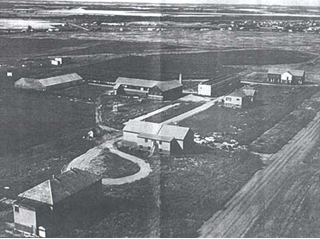 landscaped and with extensive facilities, still operate, though largely as a conference center. At least two religious meetings, including “The Feast of Pentecost” and a summer camp, are held each year, and there is also a global missions project housed there (Holdcroft 1987:7).
landscaped and with extensive facilities, still operate, though largely as a conference center. At least two religious meetings, including “The Feast of Pentecost” and a summer camp, are held each year, and there is also a global missions project housed there (Holdcroft 1987:7).
DOCTRINES/BELIEFS
The doctrines and beliefs of the Latter Rain religious revival movement are somewhat difficult to define since collectively they constitute something of a moving target, and have never been officially codified.
The movement was a protest against the more formalized Pentecostalism of the time, particularly what was considered by many to be a “dry” denominational church, lacking in emotional and spiritual life (Holdcroft 1980:2). Further, it was a movement that tended largely to privilege the mystical and subjective (prophecies, experiences, intuition, and directives straight from God) over exegeses of the written word. These prophecies and directives changed from time to time. Also, when the movement used the Bible, it did so in a highly stylized, symbolic and typological interpretation (that is, looking to the Hebrew Scriptures to interpret the New Testament) (Holdcroft 1980:2-7; Houdmann 2002:1).
Notwithstanding the above, it is possible to identify a number of teachings or beliefs, though leaders of the movement would resist the institutional implications of calling them doctrines.
First and foremost, of course, is the acceptance of the concept of The Latter Rain as found in the Hebrew Scriptures in the books of Deuteronomy (11:14), Joel (2:23) and Zechariah (10:1). These passages describe an early rain to start a crop and a latter rain to bring it to maturity for harvest. Latter Rain adherents see their revival as a sure sign that end times are imminent (Theopedia n.d.:1).
The Latter Rain movement saw the term “Latter Rain” as symbolizing a time of restoration of a victorious, universal church, including all of the apostolic gifts, in the end times, in contrast to the rather dour, pessimistic, Calvinistic dispensationalism widely held in the Pentecostalism of that period. Where the healing revivalists of the time emphasized healing and early Pentecostals emphasized tongues, Latter Rain emphasized prophecy (Riss 1987:116).
The apostolic gifts to be restored included speaking in tongues, healing, spirit blessing, prophecy, and the five-fold ministry, including prophets, apostles, evangelists, preachers and teachers. The roles of prophets and apostles, lost to the church in the Middle Ages, would now be restored to provide leadership of the victorious church, preparing the world for the return of Jesus Christ. Put another way, the Latter Rain will complete God’s work on earth, with the church united and victorious over the world, and will usher in the Kingdom of God. The movement also believed that spiritual gifts (including healing) could be received by the laying on of hands from one believer to another, in contrast to the traditional Pentecostal emphasis on “tarrying” (prayerful waiting for God’s presence) (Theopedia n.d.:1; Houdmann 2002:1-2).
Most other teachings followed from these basic beliefs, but the interpretation of these beliefs was carried out within the context of an intense, active search for a subjective, emotional, and interactive relationship with God. This meant that the prioritization and emphasis given the various elements of these beliefs tended to be shifting and circumstance-specific. Part of this circumstantial context was the belief that Christians could be demonized and require deliverance. Another part was the belief that intense, emotional praise and worship could usher God into the believers’ presence (Houdmann 2002:1-2). A somewhat unrelated belief was that women should have full and equal ministry (Houdmann 2002:2).
There are debates over whether the Latter Rain movement should be considered premillennial, postmillennial or just amillenial. Most Latter Rain believers seem to have accepted an end-times scenario in which denominational lines will be destroyed and the church will be unified by “overcomers” equipped with supernatural powers, thus preparing the world for the return of Jesus Christ and the beginning of the Kingdom of God. The role and timing of the Tribulation and the Rapture do not appear to have been settled. These issues are considered important by a number of groups, notably dispensationalist fundamentalists (Warnock 1951:83).
There was also the belief, inherited from William Branham and expanded by latter Rain teachers, notably George Warnock in his 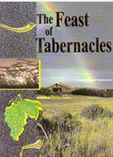 book The Feast of Tabernacles, that certain very devout members would become “The Manifest Sons of God”. Those who reached this level would have Godlike powers that included speaking any language and “teleporting” from place to place, forming an army that is able to overcome all obstacles to bring all people into geographically-organized single churches in preparation for the reign of the Lord. This prophecy is the basis for the Joel’s Army (or Overcomers) concept (Warnock 1951:83; Sanchez 2008:5).
book The Feast of Tabernacles, that certain very devout members would become “The Manifest Sons of God”. Those who reached this level would have Godlike powers that included speaking any language and “teleporting” from place to place, forming an army that is able to overcome all obstacles to bring all people into geographically-organized single churches in preparation for the reign of the Lord. This prophecy is the basis for the Joel’s Army (or Overcomers) concept (Warnock 1951:83; Sanchez 2008:5).
Defenders of Latter Rain teachings see them as “a major step in the long unfolding of Biblical truth. They place themselves on a par with the Reformers, the Puritans, the Wesleyans, and the nineteenth century evangelical revival. New Order doctrine, they believe, is the final rung in the ladder whereby God’s people climb upward as they ‘go on unto perfection’” (Holdcroft 1980:8).
RITUALS/PRACTICES
Worship services conducted by Latter Rain churches were either revival services or events modeled after them. Most were exuberant, since members came seeking an emotional and personal spiritual experience. The service could also be described, using a much later term, as interactive, since worshipers took a very active part in the service (Holdcroft 1980:10).
Since Latter Rain teaching held that intense praise and worship would usher God into the worshipers’ presence (sometimes described as the restoration of the Tabernacle of David), the early part of these services usually consisted of music, including singing in tongues, dancing and waving raised hands, and individual shouts of praise (Liichow 1997:3; Houdmann 2002:2).
Once an intense atmosphere had been established, there might be a sermon on an end times or prophecy theme, followed by an extended time of healing, casting out demons, testimony, and spirit blessing. This would again include individuals falling down “slain in the spirit,” speaking and singing in tongues, interpretation of tongues, and weeping. Healing and exorcisms were performed by the leader praying and “laying on of hands.” Early on, Latter Rain congregations developed the practice of “calling out” individuals by name, blessing them with a laying on of hands, and providing a prophecy for them (Holdcroft 1980:4-5).
The times of service tended to be flexible, again following the revival practice. If testimony and seeking continued, so did the service in most cases. Services tended to be long and to occur several times a week (conventionally Sunday morning and evening and Wednesday evening, but other times were often scheduled).
LEADERSHIP/ORGANIZATION
Initially the leadership of the Latter Rain consisted of just three men: George Hawtin, Percy Hunt, and Herrick Holt. Over time, as the movement expanded, so did the leadership group, and eventually leadership passed out of the hands of the Sharon group (Holdcroft 1980:1-4).
There does not appear to be any record of who within the early Sharon group, other than Hawtin, were among those who went to Vancouver for the William Branham meetings, save that there were “several” people. Given the timing, a fair guess is that all three were involved (Riss 1987:56-57).
But once the revival began at the school, others became involved rather quickly. With the formal beginning of the Bible school,
the three founders were soon joined by George Hawtin’s brother and brother-in-law, Ernest Hawtin and Milford Kilpatric. As the
revival gained momentum, they were also joined by George Warnock. Warnock had once been personal secretary to W. J. Ern
Baxter, who had become an associate of Branham’s ministries. Baxter himself later joined the group on a part-time basis. Warnock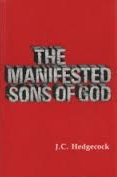 wrote a book called The Feast of Tabernacles, which has been held to be a major publication of the group, and expanded on Branham’s concept of “The Manifest Sons of God” (Riss 1987:53-62).
wrote a book called The Feast of Tabernacles, which has been held to be a major publication of the group, and expanded on Branham’s concept of “The Manifest Sons of God” (Riss 1987:53-62).
In terms of church polity, the movement established a position that strongly supported local church autonomy and opposed any form of denominationalism. One observer noted that “conflict and hostility emerged in relationships with the New Order because of their vindictive militant denunciations of existing denominations and church policies.” An oft-reported remark of one of the leaders was that “no church exercises or has any right to exercise authority of jurisdiction over another church, its pastors or members.” Yet in spite of this rhetoric and positioning, leaders of the movement did in fact exercise control, both within and without the group (Holdcroft 1980:6-7; Apologetics Index n.d.:2).
The belief that apostles and prophets were being restored to the church in this era gave rise to identifying movement leaders with these positions, and allowing them to contend that their directive prophecies came directly from God, and that, therefore, these prophecies were beyond question or challenge. Control within the group was reportedly tight, being described by at least one former member as “dictatorial” (Holdcroft 1980:5-7).
The Sharon group also formed teams of travelling “Presbyters” that included these apostles and prophets, who visited Latter Rain churches and institutions, controlling them through prophecies that were considered to have precedence over any other decision-making authority. The Sharon group has been described as rejecting any teaching that did not originate with its leaders (Holdcroft 1980:6-7).
ISSUES/CHALLENGES
The movement that came to be known as The New Order of The Latter Rain was born in controversy. One author has stated flatly that it “was an organizational schism before it was a spiritual cause.” The same author, L. Thomas Holdcroft, describes the schism as “the unrestrained zeal (of the founder and leaders of Bethel Bible Institute) pitted against the necessary conservatism and restraints of responsible denominational leaders” (Specifically the Saskatchewan District of the Pentecostal Assemblies of Canada) Holdcroft 1980:2).
This “unrestrained zeal” continued after the key players moved to North Battlefield and, over time, provided fuel for a number of other controversies. The group’s somewhat unorthodox beliefs provided sparks. Its success in drawing large numbers of members from other churches, nearly splitting the Pentecostal Assemblies denomination, fanned the flames (Holdcroft 1980:3-4).
The earliest controversies grew from the vituperative comments made, and sometimes published, by the founders regarding the leaders of other churches and denominations. Later theological controversies fall primarily into two groups, largely identifiable by the source of the criticism, though there is substantial overlap (Holdcroft 1980:6).
The first of these originated very early on and came largely from Pentecostal sources. Pentecostals rejected the use of personal prophecy, the transmission of spiritual gifts (such as healing, prophecy and tongues) by the laying on of hands from one believer to another. The also rejected what was considered by Pentecostals to be distortion of Scripture, the belief in the Manifest Sons of God predictions, and the restoration of the positions of apostle and prophet, calling all of these contrary to the historic teachings of Pentecostalism. This list of objections formed the basis for the 1949 official rejection of the Latter Rain movement by The Assemblies of God and several other Pentecostal organizations (Riss 1987:119).
Later, a fairly large number of generally fundamentalist groups published, first in books and journal articles and later on websites, objections to the eschatological teachings of the Latter Rain, to the Manifest Sons teaching, to the restorationist teaching that identified specific living apostles and prophets, to what they considered “untested” prophecy, and to what they also considered misuse, or failure to use, Scripture. One of the more succinct statements of this position is from Holdcroft: “No group can remain sound in faith and practice if it gives authority to experiences for their own sake, rather than on the ground of the standards of the Word of God” (Holdcroft 1980:10).
Another, much broader criticism comes from sources outside of these two communities and applies to Pentecostals generally and perhaps to groups within the Holiness tradition as well, but has been aimed specifically at Latter Rain teachings. That is the contention that the emotionalism, supernaturalism, tongues, healing, and other teachings concerning spiritual gifts, constitute a modern neo-Montanism, a revival of a third century Christian heresy. This is an issue that goes well beyond the scope of the present article. (“A Study of Denominations,” n.d.:1-4).
Contemporary criticism revolves not around the Latter Rain movement itself, but around the various present-day manifestations
 of teachings and practices that originated with, or were developed out of, Latter Rain teachings. Some of these include the Army of Joel and similar groups based on the Manifest Sons of God teaching (which actually came originally from William Branham), the Shepherding movement, restorationism and dominionism (Sanchez 2008:1-6).
of teachings and practices that originated with, or were developed out of, Latter Rain teachings. Some of these include the Army of Joel and similar groups based on the Manifest Sons of God teaching (which actually came originally from William Branham), the Shepherding movement, restorationism and dominionism (Sanchez 2008:1-6).
REFERENCES
Apologetics Index, Apologetics Research Resources on Religious Cults and Sects. n.d. Accessed from www.apologeticsindex.org/108.html on 29 November 2013.
Holdcroft, L.Thomas. n.d. Strange Fires, The New Order Of The Latter Rain . Accessed from www.spiritwatch.org/firelatter2.htm on 5 August 2013 .
Houdmann, S. Michael. n.d. Got Questions.org . Accessed from www.gotquestions.org/latter-rain-movement.html 5 August 2013.
Liichow, Rev. Robert S. n.d. Restoration “The Latter Rain Movement .” Accessed from www.newdiscernment.org/restorat.htm on 5 August 2013.
Riss, Richard M . 1987. Latter Rain; The Latter Rain Movement of 1948 and the Mid-Twentieth Century Evanngelical Awakening . Honeycomb Visual Productions, Ltd., Mississiauga, Ontario, Canada.
Sanchez, Casey. 2008. Todd Bentley’s Militant Joel’s Army Gains Followers in Florida .
Southern Poverty Law Center Intelligence Report , Fall. Accessed from www.splcenter.org/get-informed/intelligence-report/browse-all-issues/2008/fall/arming for armageddon on 26 November 2013.
A Study of Denominations, Montanism. n.d. Accessed from www.astudyofdenominations.com/history/montanism/ on 26 November 2013.
Warnock, George H. 1951. The Feast of Tabernacles. Bill Britton: Springfield, MO.
Author:
John C. Peterson
Post Date:
10 January 2014
